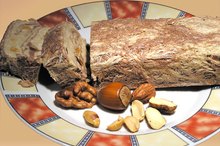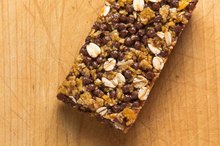What does fact checked mean?
At Healthfully, we strive to deliver objective content that is accurate and up-to-date. Our team periodically reviews articles in order to ensure content quality. The sources cited below consist of evidence from peer-reviewed journals, prominent medical organizations, academic associations, and government data.
The information contained on this site is for informational purposes only, and should not be used as a substitute for the advice of a professional health care provider. Please check with the appropriate physician regarding health questions and concerns. Although we strive to deliver accurate and up-to-date information, no guarantee to that effect is made.
Butterfinger Nutrition Information
Butterfinger candy bars combine peanuts and chocolate into a very distinct creamy yet crunchy treat. Available in five sizes, ranging from mini to giant, a single serving of about 60 g is high in calories, fat and carbohydrates. However, Butterfinger candy bars do provide some protein, calcium and iron.
Tips
Butterfinger has 467 Calories and 6.67 g of Protein per 100 gram serving according to the nutrition facts provided by the USDA Food Composition Database.
Sugars
Butterfinger candy bars contain sugar from several ingredients. Butterfingers contain a high percentage of corn syrup, a mixture of the simple sugars fructose and glucose. Other sugars in Butterfinger candy bars include sucrose, also known as table sugar. Sucrose is a disaccharide or two-sugar molecular composed of equal parts fructose and glucose, which is similar to corn syrup. Butterfingers also contain molasses, a thick viscous syrup with a bittersweet flavor. Derived from the concentrated byproduct of the refined sugar process, molasses contains some nutrients, including calcium, iron, copper, manganese, potassium and magnesium. However, the small amount included in Butterfinger candy bars does not contribute much in terms of these nutrients.
- Butterfinger candy bars contain sugar from several ingredients.
- Butterfingers contain a high percentage of corn syrup, a mixture of the simple sugars fructose and glucose.
Peanuts
Chocolate Covered Oreos Nutrition Information
Learn More
Butterfinger candy bars contain roasted peanuts, which provide protein. One Butterfinger original size bar, about 60 g, contains about 4 g of protein, equal to about 2/3 oz. of peanuts. They also contribute most of the total fat content of Butterfingers providing 9 of the 11 g of total fat per bar.
- Butterfinger candy bars contain roasted peanuts, which provide protein.
- One Butterfinger original size bar, about 60 g, contains about 4 g of protein, equal to about 2/3 oz.
Fat
Butterfinger candy bars contain 11 g of fat per original size bar. In addition to the peanuts providing fat, Butterfinger candy bars also contain hydrogenated palm kernel oil and soybean oil, although the amount of soybean oil added does not significantly contribute to the overall fat content. Because the palm kernel oil is hydrogenated, Butterfinger candy bars do not contain trans fats, the type of fat that raises your LDL or "bad" cholesterol levels and lowers your HDL or "good" cholesterol levels. Still, the total recommended daily intake of fat in a typical 2,000 calorie per day adult diet is about 65 g. Original size Butterfinger candy bars provide about 17 percent of that total.
- Butterfinger candy bars contain 11 g of fat per original size bar.
- Still, the total recommended daily intake of fat in a typical 2,000 calorie per day adult diet is about 65 g. Original size Butterfinger candy bars provide about 17 percent of that total.
Minerals and Fiber
How Many Calories Are in Fruitcake?
Learn More
Butterfinger candy bars contain ingredients such as nonfat milk, whey, molasses and peanuts that provide minerals and a very small amount of fiber, about 1 g per 60 g original size bar. Molasses and nonfat milk provide some calcium so that each bar contains about 2 percent of your daily calcium requirement. Peanuts and molasses contribute some iron, providing about 2 percent of your daily requirement of iron per bar. An entire bar, however, also provides about 270 calories. Eating plain peanuts or drinking a glass of milk would provide more nutrients for fewer calories 1.
- Butterfinger candy bars contain ingredients such as nonfat milk, whey, molasses and peanuts that provide minerals and a very small amount of fiber, about 1 g per 60 g original size bar.
- Peanuts and molasses contribute some iron, providing about 2 percent of your daily requirement of iron per bar.
Preservatives
Butterfinger candy bars contain several preservatives. Although sugars such as corn syrup often act as preservatives, Butterfingers also contain salt, TBHQ and citric acid. One bar provides 130 mg of sodium. Salt inhibits the growth of bacteria, yeast and mold. However, the 2010 Dietary Guidelines for Americans as well as the Institute of Medicine recommend limiting sodium intake to about 1,500 mg to 2,300 mg per day. One Butterfinger bar contains just less than 10 percent of this amount. TBHQ stands for tertiary butylhydroquinone, an antioxidant widely used to preserve food by preventing oils from becoming rancid. Citric acid preserves food by increasing the acidity of the food to levels that inhibit necessary bacterial enzyme activity.
- Butterfinger candy bars contain several preservatives.
- One Butterfinger bar contains just less than 10 percent of this amount.
Related Articles
References
Writer Bio
Robin Wasserman has been writing and prosecuting biochemical patents since 1998. She has served as a biochemical patent agent and a research scientist for a gene-therapy company. Wasserman earned her Doctor of Philosophy in biochemistry and molecular biology, graduating from Harvard University in 1995.









